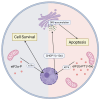Dual Nature of Mitochondrial Integrated Stress Response: Molecular Switches from Protection to Pathology
- PMID: 40870005
- PMCID: PMC12385193
- DOI: 10.3390/genes16080957
Dual Nature of Mitochondrial Integrated Stress Response: Molecular Switches from Protection to Pathology
Abstract
Background: The mitochondrial integrated stress response (ISR) represents a fundamental cellular adaptation mechanism with dual protective and pathological roles. We critically analyzed current literature on ISR mechanisms, focusing on recent paradigm shifts including the 2020 discovery of the OMA1-DELE1-HRI axis, emerging controversies over context-dependent activation patterns, and the January 2025 clinical trial failures that have reshaped the therapeutic landscape.
Methods: We reviewed recent literature (2020-2025) examining ISR mechanisms, clinical trials, and therapeutic developments through comprehensive database searches.
Results: The field has evolved from simple linear pathway models to recognition of complex, context-dependent networks. Recent findings reveal that ISR activation mechanisms vary dramatically based on cellular metabolic state, with distinct pathways operating in proliferating versus differentiated cells. The "dark microglia" phenotype in neurodegeneration and DR5-mediated apoptotic switches exemplify pathological ISR manifestations, while adaptive responses include metabolic reprogramming and quality control enhancement.
Conclusions: The 2025 failures of DNL343 and ABBV-CLS-7262 in ALS trials underscore the need for precision medicine approaches that account for context-dependent ISR functions, temporal dynamics, and disease-specific mechanisms.
Keywords: cellular adaptation; eIF2α phosphorylation; integrated stress response; mitochondrial dysfunction; neurodegeneration; precision medicine.
Conflict of interest statement
The authors declare no conflict of interest.
Figures


Similar articles
-
Computational modeling of the synergistic role of GCN2 and the HPA axis in regulating the integrated stress response in the central circadian timing system.Physiol Genomics. 2024 Aug 1;56(8):531-543. doi: 10.1152/physiolgenomics.00030.2024. Epub 2024 Jun 17. Physiol Genomics. 2024. PMID: 38881429 Free PMC article.
-
Prescription of Controlled Substances: Benefits and Risks.2025 Jul 6. In: StatPearls [Internet]. Treasure Island (FL): StatPearls Publishing; 2025 Jan–. 2025 Jul 6. In: StatPearls [Internet]. Treasure Island (FL): StatPearls Publishing; 2025 Jan–. PMID: 30726003 Free Books & Documents.
-
Identifying Therapeutic Targets for Amyotrophic Lateral Sclerosis Through Modeling of Multi-Omics Data.Int J Mol Sci. 2025 Jul 23;26(15):7087. doi: 10.3390/ijms26157087. Int J Mol Sci. 2025. PMID: 40806220 Free PMC article.
-
Blueprint of Collapse: Precision Biomarkers, Molecular Cascades, and the Engineered Decline of Fast-Progressing ALS.Int J Mol Sci. 2025 Aug 21;26(16):8072. doi: 10.3390/ijms26168072. Int J Mol Sci. 2025. PMID: 40869392 Free PMC article. Review.
-
The Redox Revolution in Brain Medicine: Targeting Oxidative Stress with AI, Multi-Omics and Mitochondrial Therapies for the Precision Eradication of Neurodegeneration.Int J Mol Sci. 2025 Aug 3;26(15):7498. doi: 10.3390/ijms26157498. Int J Mol Sci. 2025. PMID: 40806624 Free PMC article. Review.
References
-
- Levin D., Ranu R.S., Ernst V., London I.M. Regulation of protein synthesis in reticulocyte lysates: Phosphorylation of methionyl-tRNAf binding factor by protein kinase activity of translational inhibitor. Proc. Natl. Acad. Sci. USA. 1976;73:3112–3116. doi: 10.1073/pnas.73.9.3112. - DOI - PMC - PubMed
Publication types
MeSH terms
LinkOut - more resources
Full Text Sources
Medical
Miscellaneous

